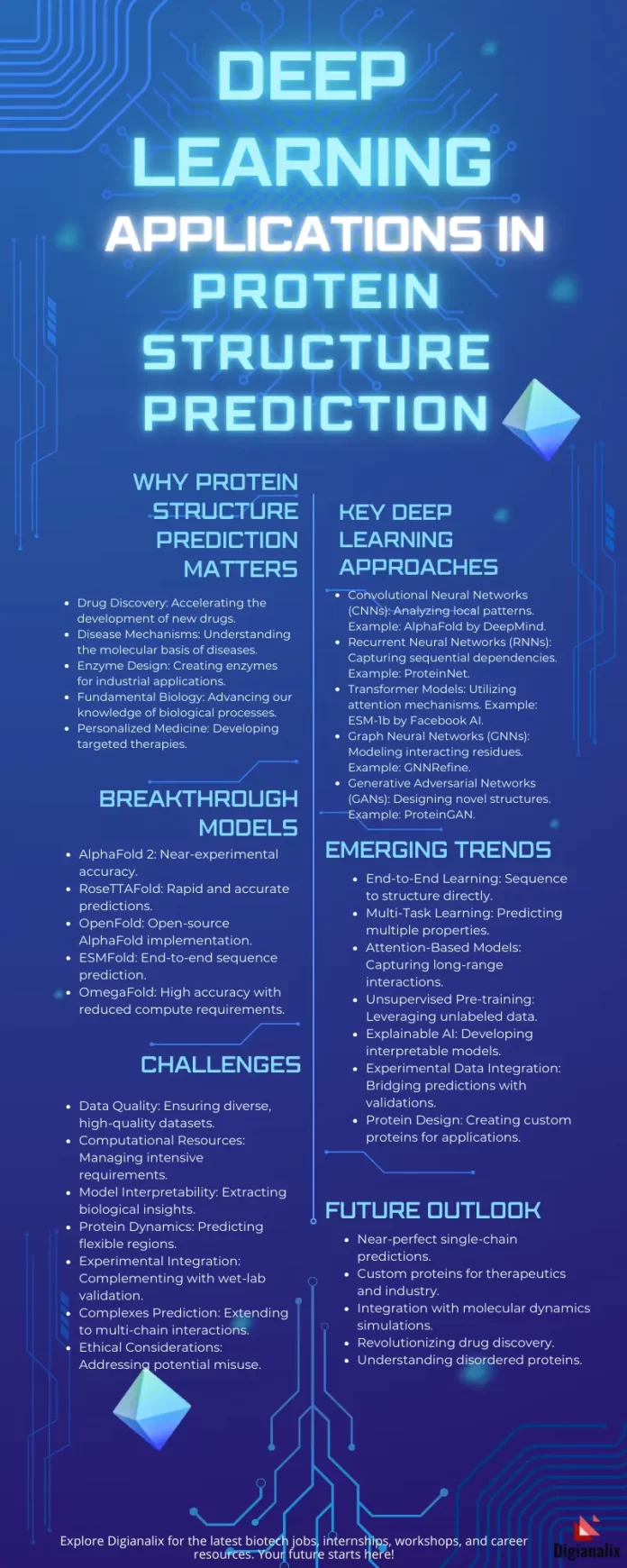Hey, bioinformatics enthusiasts and protein aficionados! 👋 Remember our journey through the transformative power of AI in biology? (If you missed it, catch up on AI in Bioinformatics: Transforming Data into Discoveries. We’ve also explored how machine learning is revolutionizing genomic analysis refresh your memory with Machine Learning Algorithms in Genomic Data Analysis. Now, let’s dive into the fascinating world of deep learning and its groundbreaking applications in predicting protein structures!
🔬 Why Protein Structure Prediction Matters Understanding protein structures is crucial for:
- Drug discovery and development
- Understanding disease mechanisms
- Designing enzymes for industrial applications
- Advancing our knowledge of fundamental biology
- Developing targeted therapies and personalized medicine
Let’s explore how deep learning is revolutionizing this field in 2024!
🧠 Key Deep Learning Approaches in Protein Structure Prediction
Convolutional Neural Networks (CNNs)
Technique: Analyzing local patterns in protein sequences Example: DeepMind’s AlphaFold uses CNNs to process evolutionary information
Recurrent Neural Networks (RNNs)
Technique: Capturing sequential dependencies in protein chains Example: ProteinNet utilizes bidirectional LSTMs for sequence analysis
Transformer Models
Technique: Leveraging attention mechanisms for long-range interactions Example: Facebook AI’s ESM-1b model for protein language modeling
Graph Neural Networks (GNNs)
Technique: Modeling protein structures as graphs of interacting residues Example: GNNRefine for refining predicted protein structures
Generative Adversarial Networks (GANs)
Technique: Generating realistic protein structures Example: ProteinGAN for designing novel protein sequences and structures
🌟 Breakthrough Deep Learning Models in Protein Structure Prediction
- AlphaFold 2: DeepMind’s revolutionary model achieving near-experimental accuracy
- RoseTTAFold: University of Washington’s rapid and accurate structure prediction tool
- OpenFold: Open-source implementation of AlphaFold architecture
- ESMFold: Meta AI’s end-to-end single sequence structure prediction model
- OmegaFold: Developed by HeliXon, achieving high accuracy with reduced compute requirements
💡 Emerging Trends in Deep Learning for Protein Structure Prediction
End-to-End Learning
Focus: Direct prediction from sequence to structure without intermediate steps Potential: Streamlining the prediction process and improving accuracy
Multi-Task Learning
Focus: Simultaneously predicting multiple protein properties Opportunity: Enhancing model generalization and biological relevance
Attention-Based Models
Focus: Capturing long-range interactions in protein sequences Frontier: Improving predictions for large, complex proteins
Unsupervised Pre-training
Focus: Leveraging vast amounts of unlabeled protein sequence data Application: Enhancing model performance on limited labeled data
Explainable AI in Structure Prediction
Focus: Developing interpretable models for biological insights Challenge: Balancing model complexity with interpretability
Integration of Experimental Data
Focus: Incorporating sparse experimental data to guide predictions Opportunity: Bridging computational predictions with experimental validations
Protein Design and Engineering
Focus: Using generative models to design novel proteins with desired properties Frontier: Creating custom proteins for therapeutic and industrial applications
🤝 Collaborations Driving Innovation
- Academic-Industry Partnerships: e.g., DeepMind and EMBL-EBI collaboration on AlphaFold DB
- Open Science Initiatives: e.g., CASP (Critical Assessment of protein Structure Prediction) competition
- Interdisciplinary Research Teams: Combining expertise in ML, structural biology, and biochemistry
- Cloud Computing Collaborations: e.g., Google Cloud’s support for AlphaFold runs
- Pharma-AI Alliances: e.g., Exscientia’s partnerships for AI-driven drug discovery
🚦 Challenges in Deep Learning for Protein Structure Prediction
- Data Quality and Bias: Ensuring diverse, high-quality training datasets
- Computational Resources: Managing the intensive computing requirements of large models
- Model Interpretability: Extracting biological insights from complex neural networks
- Handling Protein Dynamics: Predicting flexible and disordered regions accurately
- Integration with Experimental Methods: Complementing computational predictions with wet-lab validation
- Predicting Protein Complexes: Extending methods to multi-chain and protein-ligand interactions
- Ethical Considerations: Addressing potential misuse in designing harmful proteins
🔮 Future Outlook The future of deep learning in protein structure prediction is incredibly promising, with potential for:
- Near-perfect accuracy in single-chain protein structure prediction
- Rapid design of custom proteins for therapeutic and industrial applications
- Integration of structure prediction with molecular dynamics simulations
- Revolutionizing drug discovery through accurate protein-ligand interaction predictions
- Unraveling the mysteries of intrinsically disordered proteins
What deep learning applications in protein structure prediction excite you the most? Are you involved in computational structural biology research? Share your thoughts and experiences in the comments below!
Stay updated on the latest in AI-powered structural biology by subscribing to our site. Let’s unfold the secrets of life’s molecular machines together!




